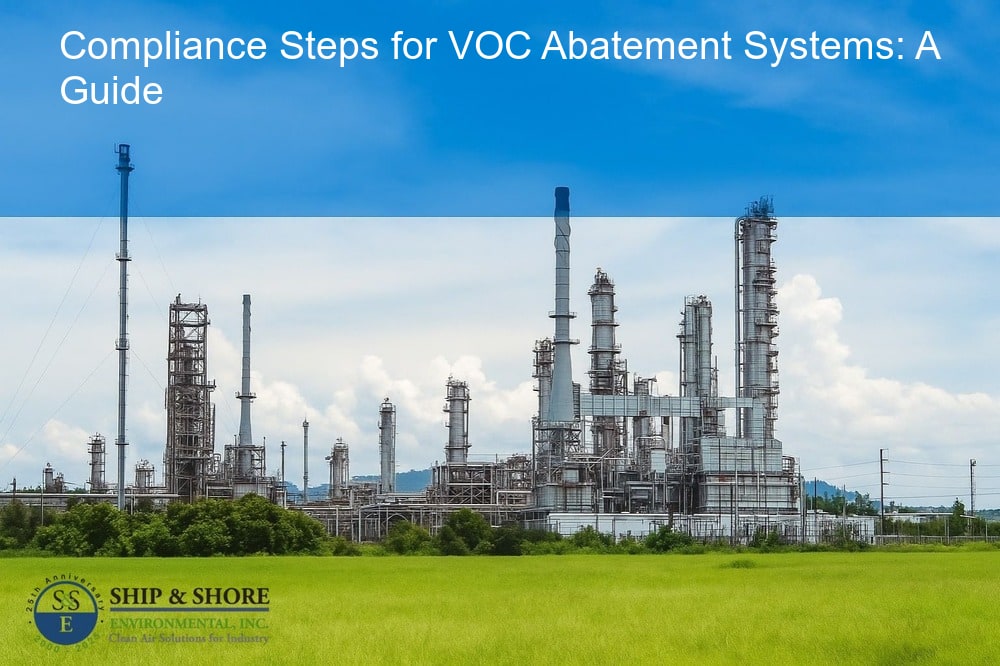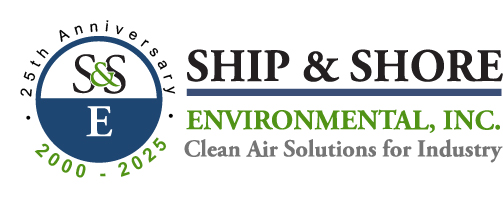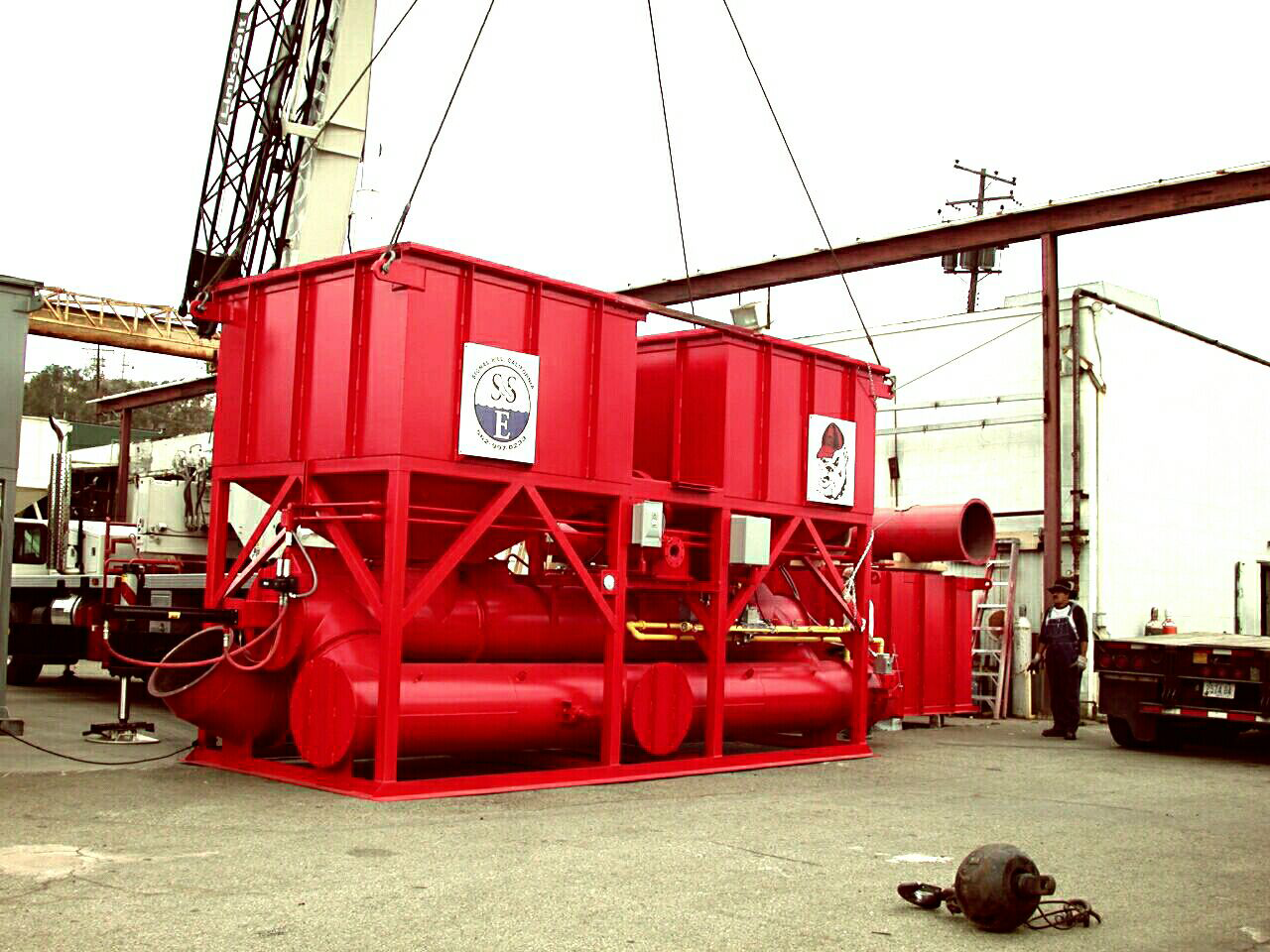
Compliance Steps for VOC Abatement Systems: A Stepwise Guide
October 22, 2025 10:08 amUnderstanding VOC Abatement Systems: An Overview
Compliance steps for VOC abatement systems are fundamental to both legal adherence and environmental protection. At Ship & Shore Environmental, Inc., we recognize the complex landscape companies navigate when managing volatile organic compounds (VOCs). Emissions of VOCs are not just regulatory concerns; they pose significant health and environmental risks. VOC abatement systems are engineered solutions designed to capture and destroy these harmful compounds before they can be released into the atmosphere. This overview will serve as the foundation for our detailed discussion on navigating compliance in this crucial area.
The Imperative of Compliance: Legal and Environmental Perspectives
Failure to adhere to VOC regulations can lead to substantial financial penalties, legal repercussions, and reputational damage. Regulations vary across different jurisdictions, but the common thread is the increasing rigor applied to VOC emissions. Beyond the legalities, there is a compelling environmental argument. VOCs contribute to the formation of ground-level ozone and smog, which can harm human health, damage vegetation, and degrade materials. Understanding the imperative of compliance from both these perspectives ensures we are not only meeting legal requirements but also playing a part in the broader environmental stewardship.
Setting the Stage: What Will Our Discussion Entail?
As we progress, our discussion will cover the critical steps required for managing VOC abatement systems effectively. We will start by addressing the identification of needs and selection of appropriate systems, ensuring these solutions are tailored to specific operational contexts. Next, we will explore the best practices for the proper installation and integration of these systems to ensure they function optimally from day one. Finally, we will delve into the importance of regular maintenance and inspections, crucial for maintaining compliance and operational efficiency over time. Each of these steps plays a vital role in the broader strategy of minimizing VOC emissions and meeting regulatory demands.
Step One: Identifying the Need and Selecting Appropriate VOC Abatement Systems
Before embarking on any VOC abatement journey, it’s crucial to understand the specific requirements and environmental impact of your facility. Identifying the exact need for a VOC abatement system involves a comprehensive assessment of your emissions and regulatory obligations.
First, conducting a thorough analysis of the types and volumes of VOCs emitted is essential. This analysis will guide you in selecting the right abatement system tailored to your operational needs. For instance, if your facility generates substantial VOC emissions, thermal oxidizers might be the best option. On the other hand, for facilities with lower VOC concentrations, carbon adsorption systems could be more suitable.
Once the need is identified, scrutinizing available technologies and their compliance records is paramount. A tripartite evaluation – considering efficiency, operational cost, and maintenance needs – will ensure that the selected system aligns with both regulatory requirements and your operational objectives. Given that VOC abatement systems are a long-term investment, this step cannot be skipped.
Step Two: Ensuring Proper Installation and Integration of VOC Abatement Systems
Once the appropriate VOC abatement system is selected, the next compliance step for VOC abatement systems is ensuring its correct installation and seamless integration into your existing infrastructure. This stage is critical for operational efficiency and regulatory compliance.
Collaborating with experienced vendors and contractors can make a significant difference here. They will ensure that the system is installed according to both manufacturer specifications and compliance guidelines. During installation, it is crucial to verify that all system components are correctly positioned and connected. This reduces the risk of operational hiccups and compliance violations in the future.
Moreover, integration does not end with physical installation. Ensuring that the new system works harmoniously with your current operations involves reviewing and, if necessary, updating operational protocols, safety guidelines, and staff training programs. Conducting initial performance tests and calibrations to validate that the system meets regulatory standards is equally important.
Step Three: Harnessing Regular Maintenance and Inspections for Compliance Assurance
To maintain compliance and operational efficiency, regular maintenance and inspections are indispensable. Establishing a robust maintenance plan is the most effective way to ensure that your VOC abatement system operates at optimum levels, thus meeting all regulatory norms.
Plan periodic inspections by qualified personnel to detect any potential malfunctions or wear and tear. These inspections should focus on critical components such as filters, catalysts, and fan systems to ensure they are functioning correctly. Regular maintenance activities, including cleaning and replacing worn parts, should be scheduled and diligently recorded.
- Bi-annual comprehensive system audits
- Monthly performance reviews
- Quarterly emissions testing
- Annual regulatory compliance checks
Utilizing advanced monitoring tools and software can enhance the oversight of your VOC abatement system. With real-time data tracking and automated alerts, you can swiftly address any issues that arise, ensuring that corrective actions are taken in a timely manner. Additionally, consistent documentation of all maintenance activities, inspections, and any incidents is crucial for compliance purposes. This documentation serves as evidence of your commitment to maintaining VOC abatement systems in line with regulatory standards.
Did you know? Regular maintenance and inspection of VOC abatement systems not only ensure compliance but also advance environmental stewardship by reducing air pollution.
Looking Ahead: The Future of VOC Abatement Systems and Compliance Requirements
As we move forward, understanding and adapting to the evolving landscape of VOC abatement systems is essential. The regulatory environment is becoming increasingly stringent, and staying ahead of compliance requirements is not just a legal necessity but also a competitive advantage. At Ship & Shore Environmental, Inc., we are committed to helping you navigate these changes with ease and confidence. We continually innovate and refine our technologies to ensure that your facilities not only meet but exceed regulatory standards.
Achieving More: Beyond Compliance to Environmental Stewardship
While compliance steps for VOC abatement systems are critical, our mission extends beyond mere compliance. We aim to foster a culture of environmental stewardship. This means optimizing systems to minimize environmental impact and enhance sustainability. By investing in state-of-the-art abatement systems, businesses can significantly reduce their carbon footprint and contribute to a healthier planet. Our team provides comprehensive support – from system design to ongoing maintenance – to ensure that your VOC abatement efforts are both effective and sustainable.
Final Thoughts: Why Compliance Steps for VOC Abatement Systems Matter
The importance of rigorous compliance steps for VOC abatement systems cannot be overstated. Adhering to these steps protects your business from legal penalties and fosters a safer, more sustainable environment. It reflects a commitment to responsible practices that benefit both your organization and the broader community. At Ship & Shore Environmental, Inc., we are here to support you every step of the way, offering expertise, technology, and services that make compliance both achievable and advantageous. Together, we can create a future where industrial progress and environmental responsibility go hand in hand.
FAQ
What are the key compliance steps for a VOC abatement system?
The key compliance steps include identifying the need for a system, selecting the appropriate abatement technology, ensuring professional installation and integration, and conducting regular maintenance and inspections. These steps ensure that the system operates efficiently and complies with environmental regulations. Furthermore, it’s important to stay informed about future regulatory changes to maintain compliance.
How does Ship & Shore Environmental, Inc. ensure that our VOC abatement systems stay ahead of regulatory changes?
At Ship & Shore Environmental, Inc., we continuously monitor regulatory developments and innovate our technology to exceed standards. We understand that regulations may evolve, so our team focuses on forward-thinking designs and processes that anticipate forthcoming environmental requirements. This proactive approach ensures that our clients’ systems remain compliant and efficient in the long run.
Why is it important to go beyond just complying with VOC regulations?
While adhering to VOC regulations is essential, going beyond compliance signifies a commitment to environmental stewardship. It involves optimizing abatement systems not only to meet but to surpass environmental standards, thereby reducing the carbon footprint and contributing to a more sustainable future. At our core, we believe in helping businesses achieve superior environmental performance that benefits us all.
Can Ship & Shore Environmental, Inc. assist with system design and maintenance?
Yes, Ship & Shore Environmental, Inc. offers comprehensive services that encompass custom system design, integration, and ongoing maintenance support. Our expertise ensures that your VOC abatement system operates at peak efficiency and compliance, thereby safeguarding your business against potential legal penalties and promoting environmental health. Our dedicated team provides continuous assistance to meet and exceed your abatement objectives.
How does investing in VOC abatement technology benefit my business in the long term?
Investing in advanced VOC abatement technology from Ship & Shore Environmental, Inc. not only ensures compliance with current regulations but also sets your business up for long-term success. It prepares you for stricter future standards and demonstrates your dedication to sustainability, potentially leading to cost savings, improved community relations, and enhanced market positioning. Such investments can lead to a more favorable public perception and increased business opportunities.
Categorised in: Blog

